Click on images to enlarge
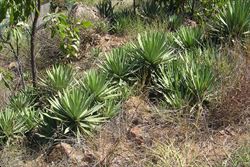
infestation on a hillside (Photo: Chris Gardiner)
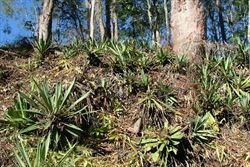
partially controlled infestation in bushland near Enoggera Creek in Brisbane (Photo: Sheldon Navie)
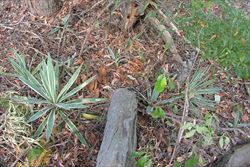
a small infestation of variegated Caribbean agave (Agave angustifolia 'Marginata') in Stuartholme in Brisbane (Photo: Sheldon Navie)
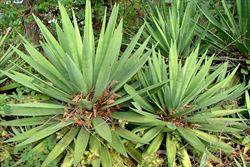
habit (Photo: Sheldon Navie)
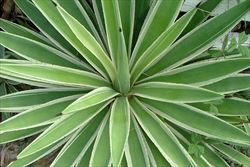
habit of Agave angustifolia 'Marginata' (Photo: Sheldon Navie)

habit in fruit (Photo: Chris Gardiner)

habit of Agave angustifolia 'Marginata' in fruit (Photo: Sheldon Navie)

light green leaves (Photo: Sheldon Navie)
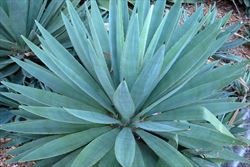
bluish-grey leaves (Photo: Sheldon Navie)
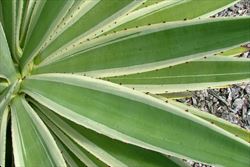
the variegated leaves of Agave angustifolia 'Marginata' (Photo: Sheldon Navie)
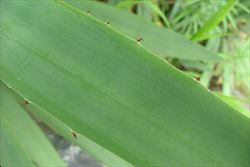
close-up of a leaf showing its prickly margins (Photo: Sheldon Navie)

the large dark-brown spine at the leaf tip (Photo: Sheldon Navie)
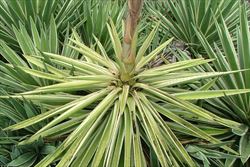
older leaves and base of flowering stem of Agave angustifolia 'Marginata' (Photo: Sheldon Navie)
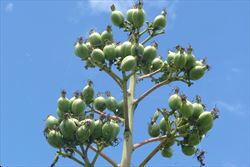
immature fruit (Photo: Sheldon Navie)
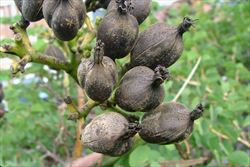
close-up of mature fruit (Photo: Sheldon Navie)
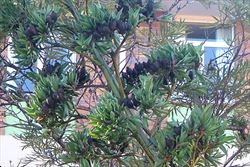
part of inflorescence with mature fruit and numerous plantlets (Photo: Sheldon Navie)
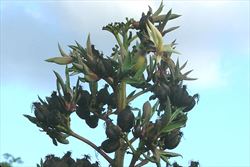
part of inflorescence of Agave angustifolia 'Marginata' with mature fruit and plantlets (Photo: Sheldon Navie)
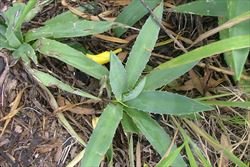
young plant (Photo: Sheldon Navie)
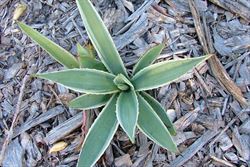
young Agave angustifolia 'Marginata' plant (Photo: Sheldon Navie)
Scientific Name
Agave angustifolia Haw.
Note: the Queensland Herbarium currently recognises this species by the name Agave vivipara L.
Synonyms
Agave vivipara L.
(misapplied)
Agave vivipara L. var. vivipara
(misapplied)
Family
Agavaceae
Common Names
Caribbean agave, century plant, maguey, narrow-leaved century plant
Origin
Native to Mexico and Central America.
Naturalised Distribution
Naturalised in the coastal districts of south-eastern Queensland (i.e. in the Moreton and Wide Bay districts), though its actual distribution may be underestimated by herbarium records.
Also naturalised in the coastal districts of central and northern Queensland, as well as in north-eastern New South Wales.
The cultivar known as variegated Caribbean agave (Agave angustifolia 'Marginata') is also sparingly naturalised in south-eastern Queensland.
Habitat
A weed of roadsides, railway lines, embankments, cliffsides, disturbed sites and waste areas. It also grows in open woodlands, in coastal environs, on creekbanks and in vegetation along watercourses.
Habit
A long-lived (i.e. perennial) shrubby plant forming very large rosettes of leaves 0.5-1 m tall and 1-1.5 m across. Older individuals develop a very short woody trunk at the base, and when fully mature they produce a massive flower cluster on a robust flowering stem 3-5 m tall. Plants also produce numerous suckers and eventually form a large clump or colony.
Distinguishing Features
- a long-lived shrubby plant forming large rosettes of leaves up to 1 m tall
and 1.5 m across.
- its large fleshy leaves are long and narrow (30-80 cm long and 3.5-10 cm
wide) in shape.
- these rigid leaves have prickly margins and a pointed tip topped with a
large dark-brown coloured spine (1.5-3.5 cm long).
- mature plants produce a massive flower cluster (1-2 m long) on a robust
flowering stem 3-5 m tall.
- the greenish-yellow flowers (5-6.5 cm long) are borne in an
upright position and have six very large protruding stamens.
- the large capsules (about 5 cm long and 3 cm wide) have a pointed tip and
turn dark brown or blackish in colour as they mature.
- plantlets are often also produced in clusters near the tips of the flowering branches.
Stems and Leaves
The short woody stems of this species are usually less than 0.5 m tall and are mostly hidden by the leaves. Massive green flowering stems are eventually produced, which have alternately arranged bract-like leaves.
The very large leaves are long and narrow (i.e. lanceolate) in shape and arranged in a rosette. They are usually rigid and somewhat fleshy (i.e. succulent), and are slightly thickened towards the base. These leaves (30-80 cm long and 3.5-10 cm wide) may be upright (i.e. erect or ascending) or spreading. They are usually light green to greyish-green or bluish-grey in colour, but a variegated form with whitish or yellowish margins (i.e. Agave angustifolia 'Marginata') is also present in naturalised populations. Their margins are armed with small reddish-brown or dark brown prickly teeth (2-5 mm long) that are borne 1-2 cm apart. They are also hairless (i.e. glabrous) and have a pointed tip (i.e. acute apex) topped with a large dark-brown coloured spine (1.5-3.5 cm long).
Flowers and Fruit
The massive flower clusters (1-2 m long) are borne at the top of a very robust flowering stem. These flower clusters have 10-20 branches, with the branches being further divided towards their tips (i.e. they are terminal panicles). Individual flowers are borne in an upright (i.e. erect) position on short stalks (i.e. pedicels). These greenish-yellow flowers (5-6.5 cm long) are borne in groups towards the tips of the branches. They have six 'petals' (i.e. perianth segments or tepals) that are fused together at the base into a short tube (8-16 mm long) with spreading lobes (18-24 mm long). The flowers also have six very large stamens, consisting of stalks (i.e. filaments) 3.5-4.5 cm long and yellow anthers (20-30 mm long). They also have a large ovary topped with a style and three stigmas.
The fruit is a large egg-shaped (i.e. ovoid) capsule (about 5 cm long and 3 cm wide) with a pointed tip (i.e. beaked apex) and consists of three compartments. These capsules turn from green to dark brown or blackish in colour as they mature and eventually split open to release their seeds. The large seeds (9-12 mm long and 7-8 mm wide) are dull black in colour and somewhat flattened. A few to numerous plantlets (i.e. bulbils) are sometimes also produced in clusters near the tips of the flowering branches.
Reproduction and Dispersal
This species reproduces by seed, but the majority of reproduction is probably vegetative. It produces numerous suckers and often also develops plantlets (i.e. bulbils) on the branches of its flower clusters.
Caribbean agave (Agave angustifolia) spreads laterally via suckers and can form very large and dense colonies over time. The plantlets (i.e. bulbils), which usually fall from a significant height, are dispersed by gravity and may also be spread downstream during floods. Plants and bulbils are also commonly spread into bushland areas in dumped garden waste.
Legislation
This species is not currently declared under any state or local government legislation.
Management
As this species is not a declared plant, its control is not required and there are no restrictions on its sale or cultivation. However, it is an environmental weed and should be controlled in sensitive bushland and conservation areas.
Similar Species
Caribbean agave (Agave angustifolia) is very similar to Florida agave (Agave decipiens), maguey (Agave cantula) and sisal (Agave sisalana). These species can be distinguished by the following differences:
- Caribbean agave (Agave angustifolia) has very short
basal stems, usually less than 0.5 m tall. Mature plants have relatively
small light green, greyish-green or variegated leaves (usually 30-60 cm long)
that are usually very rigid. These leaves have numerous small prickles (2-5 mm
long) along their margins. This species produces large capsules and sometimes
also develops numerous plantlets (i.e. bulbils) on the branches of its flower
clusters.
- Flordia agave (Agave decipiens)
has relatively tall basal stems, usually more than 0.5 m tall. Mature
plants have moderately large green leaves (usually 70-100 cm long) that are
usually rigid with very swollen bases. These leaves have numerous small prickles (2-3 mm long)
along their margins. This species usually doesn't produce capsules in
south-eastern Queensland, instead developing numerous plantlets (i.e. bulbils)
on the branches of its flower clusters.
- maguey (Agave cantula) has very short basal stems,
usually less than 0.5 m tall. Mature plants have relatively large green or
greyish-green leaves (usually 100-200 cm long) that are relatively thin and
flexible. These leaves have some small prickles (2-4 mm long) along their
margins. This species usually doesn't produce capsules in south-eastern
Queensland, instead developing numerous plantlets (i.e. bulbils) on the
branches of its flower clusters.
- sisal (Agave sisalana) has very short basal stems, usually less than 0.5 m tall. Mature plants have relatively large green or greyish-green leaves (usually 90-130 cm long) that are usually very rigid. These leaves do not have any prickles along their margins. This species usually doesn't produce capsules in south-eastern Queensland, instead developing numerous plantlets (i.e. bulbils) on the branches of its flower clusters.
Caribbean agave (Agave angustifolia) may also be confused with century plant (Agave americana) and the false agaves (i.e. Furcraea spp.). However, century plant (Agave americana) has broader leaves (15-25 cm wide) and the false agaves (i.e. Furcraea foetida and Furcraea selloa) can be distinguished by their drooping flowers.
Notes
Caribbean agave (Agave angustifolia) has escaped from cultivation as a garden ornamental and become naturalised in eastern Queensland and north-eastern New South Wales. It is naturalised in a wide variety of habitats in the region, often becoming established after being dumped in garden waste. A cultivar of this species with variegated leaves, known as variegated Caribbean agave (Agave angustifolia 'Marginata'), is also very popular in cultivation in Australia. It is occasionally also present in naturalised populations.
Caribbean agave (Agave angustifolia) is regarded as an environmental weed in south-eastern Queensland, and is ranked among the 200 most invasive plant species in this region. It has commonly been recorded as a weed of coastal sand dunes, sea cliffs and offshore islands (e.g. Peel Island). However, it is also a weed of roadsides, railway lines, disturbed sites, waste areas, abandoned gardens, urban bushland, riparian vegetation, hillsides and open woodlands in other parts of the region.
This species is not restricted to this part of the state, with the first naturalised specimen being collected at Rockhampton in 1956. Caribbean agave (Agave angustifolia ) is particularly problematic in coastal environs and is listed among the 35 most troublesome weed species occurring on Queensland's east coast sandy beaches and dunes. It was also recently recorded from north-eastern New South Wales, where it was growing on sandy soil in a coastal banksia woodland in the Yamba area.

